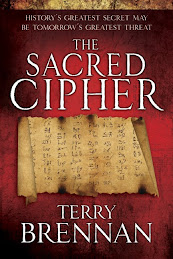Did you ever dream of breaking a secret code? Well, here's your chance.
This month, we're going to give you a little sneak peek at one of the plot elements that help drive The Sacred Cipher. And we'll also give you a chance to solve a 100-year-old code that has never been broken.
****
He was a chemist – in his basement. He was a cryptographer and code breaker – in his spare time. He went to work in an insane asylum – to find the peace he sought to compose music.
Sir Edward Elgar, one of the most beloved and influential English composers of this age … a romantic scientist of music … died 75 years ago.
Elgar passed away on February 23, 1934. Yet, his music is as alive today – as modern and well-known; as ingrained in our society – as the music of the Beatles.
Who is Edward Elgar?
Have you ever heard the Pomp and Circumstances March … the music that is played at every school graduation ceremony? Then you’ve heard Sir Edward Elgar.
But, if you watch much TV, or many movies, then you’re likely to have also heard Sir Edward Elgar’s work. There was a series on television about World War II – Band of Brothers. Click on this youtube connection below and see if this sounds familiar.
http://www.youtube.com/watch?v=sUgoBb8m1eE
This music is Nimrod, one of the “Variations on an Original Theme” Elgar wrote to widespread acclaim in 1899 – his now famous Enigma Variations, some of the most beautiful music this world has ever heard. Elgar’s compositions are vast and varied, far too many to comment on here – his Cello Concerto; the Music Makers; his 1st Symphony and his masterful the Dream of Gerontius (1900).
The 75th Anniversary of Elgar’s death will be celebrated on February 28th by a commemorative concert played by the renowned English Symphony Orchestra (ESO) at the Worcester Cathedral in England. Continuum has just published a book on Elgar, Elgar: An Anniversary Portrait … Introduced by Nicholas Kenyon. The liner notes read:
This collection of essays offers a new insight into the composer's life.
Edward Elgar was a man of many contradictions. He was born an outsider, into a family of lower-middle class, Catholic, origins. Yet his fame, and ability to write music that struck a chord in the national consciousness, led him to adopt a sycophantic attitude towards the Royal Family and high society, even though he always felt ill at ease with them.
Elgar was a depressive with a problematic marriage, who craved recognition, but in many ways he regretted the piece of music which made him famous. 'Pomp and Circumstance' made him the leading English composer of his age, but also contributed to the jingoism which he so disliked during the First World War. Yet, unquestionably, he was the greatest musical genius that England had produced in centuries.
This Portrait, by some of the scholars and musicians that understand him best, offers new light on a wide range of aspects of Edward Elgar's life and work.
Why do I care about Sir Edward Elgar? On the surface, my interest has little direct connection to his music. It has to do with the Dorabella Cipher – a code Elgar wrote in 1897 as a birthday present to a friend … a code that has never been broken.
The Dorabella Cipher is one of the key elements that Tom Bohannon and his team – Dr. Richard Johnson, Sammy Rizzo and Joe Rodriguez – use to solve the mystery of The Sacred Cipher, my first novel which will be published by Kregel Publications and released on July 31.
The Elgar Society (http://www.elgar.org/) holds an annual competition for those code-breakers who are attempting to crack the Dorabella Cipher. In 2008 there were seven entries submitted, but the cipher remains a mystery and the £1,500 prize has yet to be awarded.
Can you break the Dorabella Cipher written by Sir Edward Elgar?
If you want to win the prize, perhaps reading The Sacred Cipher may help. But, if you can't wait the five monts until the book is released, next month, we'll give you some more history of the Dorabella Cipher, and some more clues.
And, oh yeah, Sir Edward Elgar is the man who opened the EMI Recording Studios on Abbey Road in November, 1931. You remember Abbey Road, right? Some English group made an album of that title. Can’t quite remember their name.
Click below to see a rare piece of film - Elgar conducting his Pomp and Circumstance at the opening of the Abbey Road Studios.
http://www.youtube.com/watch?v=gxqFdcZz974


2 comments:
A new solution to Elgar's Enigma Theme has been found: "A Mighty Fortress is our God."
http://enigmathemeunmasked.blogspot.com/
The solution is Pi. The first four notes are scale degree 3-1-4-2, decimal Pi. The "dark saying" is "Four and twenty blackbirds (dark) baked in a pie (Pi.) The first four and twenty notes of the enigma variations are all blackbirds (black notes with wings- slurs or ties). Elgar also hid fractional Pi, 22/7, in the first four bars. The two "drops of a seventh in the 3rd and 4th bar" follow exactly after the first 11 notes. This leads to 11 x 2/7 = 22/7. EV was composed in the year following one of the greatest japes of all time, The Indiana Pi Bill of 1897 which attempted to leglislate the value of Pi.
Post a Comment